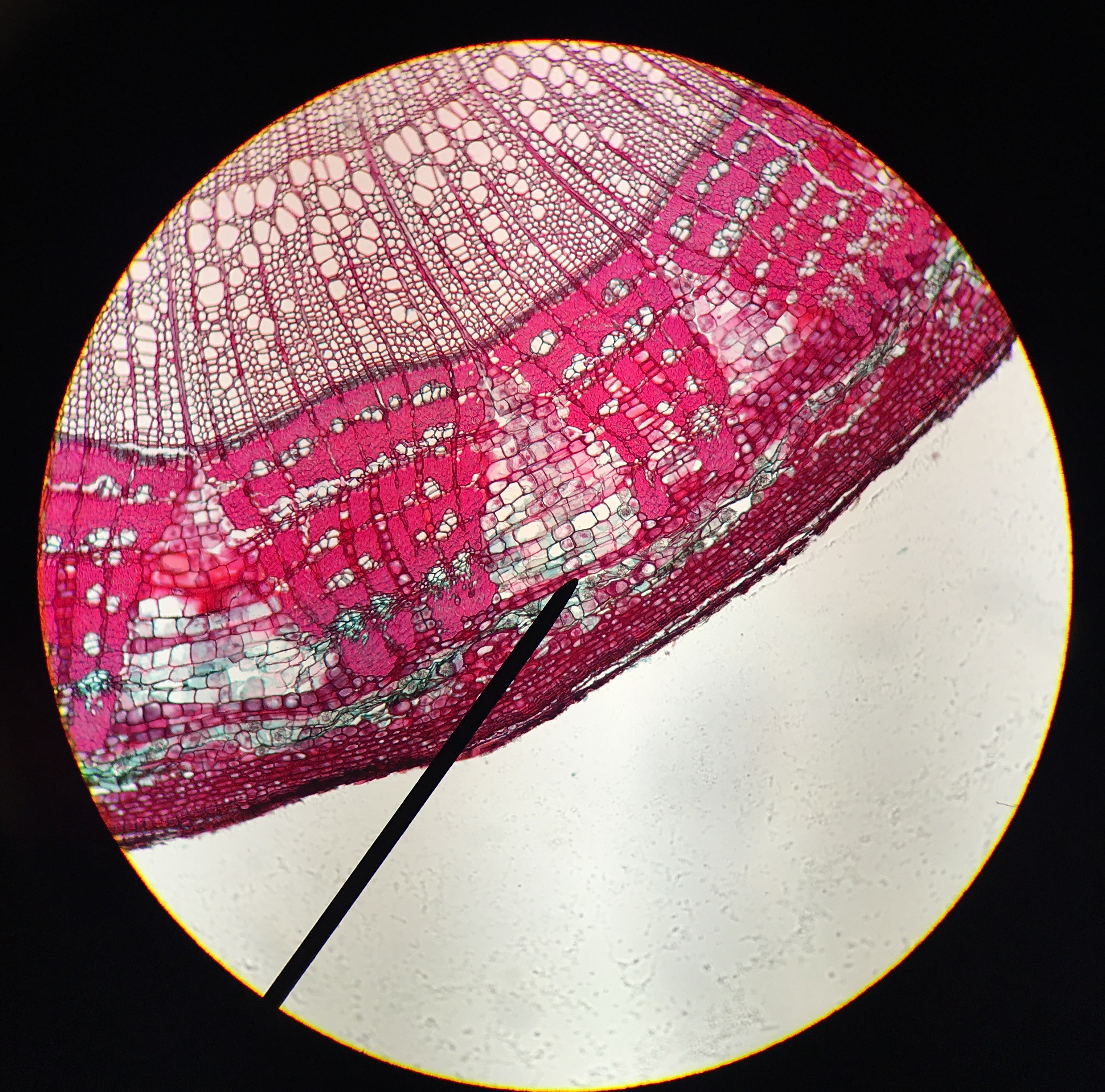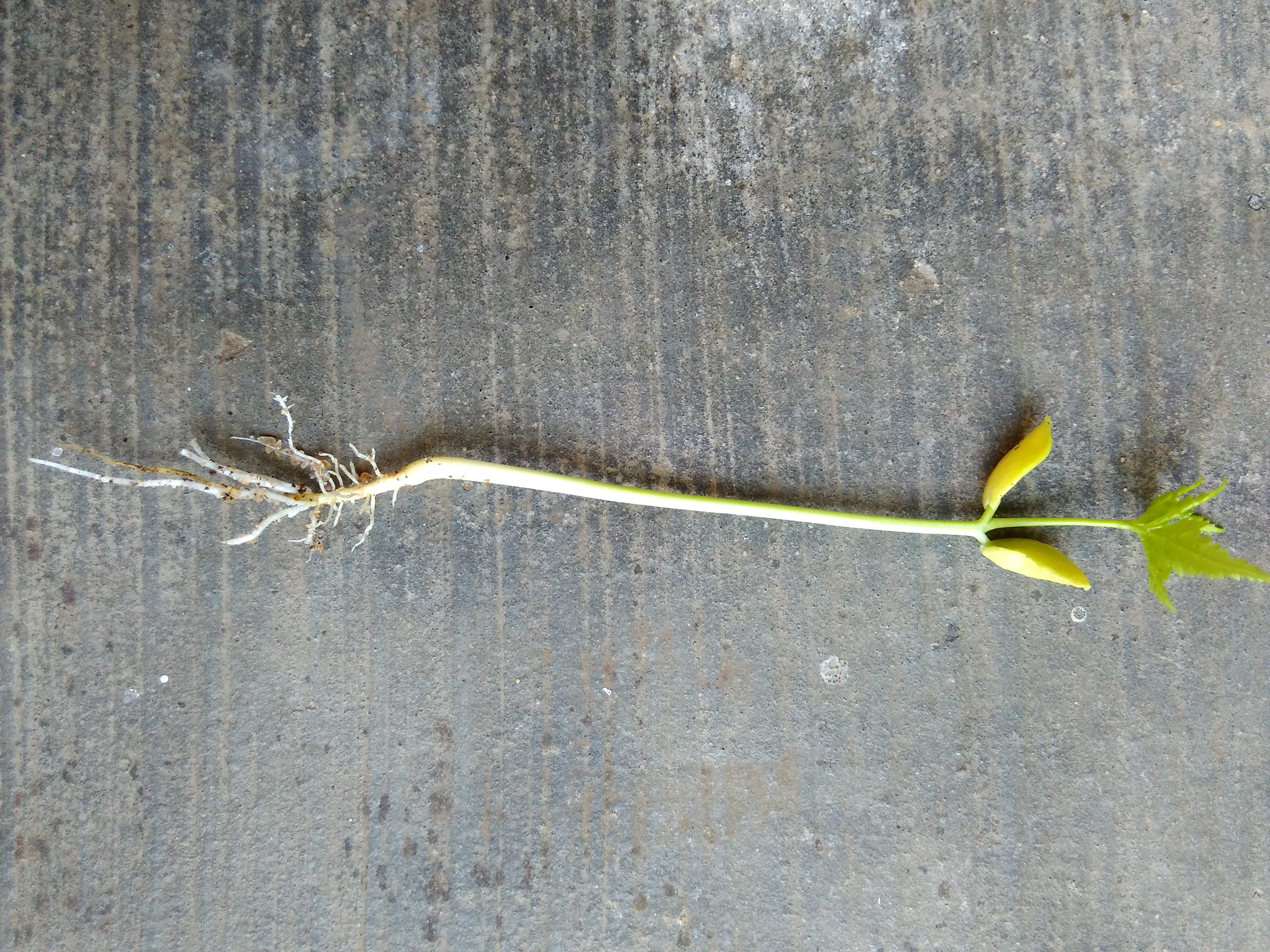|
Epidermis (botany)
The epidermis (from the Greek language, Greek ''ἐπιδερμίς'', meaning "over-skin") is a single layer of cells that covers the leaf, leaves, flowers, roots and Plant stem, stems of plants. It forms a boundary between the plant and the external environment. The epidermis serves several functions: it protects against water loss, regulates gas exchange, secretes metabolic compounds, and (especially in roots) absorbs water and mineral nutrients. The epidermis of most leaves shows Anatomical terms of location#Dorsal and ventral, dorsoventral anatomy: the upper (adaxial) and lower (abaxial) surfaces have somewhat different construction and may serve different functions. Woody stems and some other stem structures such as potato tubers produce a secondary covering called the periderm that replaces the epidermis as the protective covering. Description The epidermis is the outermost cell layer of the primary plant body. In some older works the cells of the leaf epidermis have been ... [...More Info...] [...Related Items...] OR: [Wikipedia] [Google] [Baidu] |
Pavement Cell
Pavement cells are a cell type found in the outmost epidermal layer of plants. The main purpose of these cells is to form a protective layer for the more specialized cells below. The arrangement and undulating geometry of these cells are demonstrated to enhance the epidermal tear resistance by extending the path of cracks and hindering their progression along cell interfaces, thereby preserving the plant epidermal integrity. This layer helps decrease water loss, maintain an internal temperature, keep the inner cells in place, and resist the intrusion of any outside material. They also separate stomata apart from each other as stomata have at least one pavement cell between each other. They do not have a regular shape. Rather, their irregular shapes help them to interlock with each other like puzzle pieces to form a sturdy layer. This irregular shape that each individual cell takes on can be influenced by the cytoskeleton and specific proteins. As the leaf grows, the pavement cells w ... [...More Info...] [...Related Items...] OR: [Wikipedia] [Google] [Baidu] |
Cork Cambium
Cork cambium (: cambia or cambiums) is a tissue found in many vascular plants as a part of the epidermis. It is one of the many layers of bark, between the cork and primary phloem. The cork cambium is a lateral meristem and is responsible for secondary growth that replaces the epidermis in roots and stems. It is found in woody and many herbaceous dicots, gymnosperms and some monocots (monocots usually lack secondary growth). It is one of the plant's meristems – the series of tissues consisting of embryonic disk (incompletely differentiated) cells from which the plant grows. The function of cork cambium is to produce the cork, a tough protective material.Junikka, L. (1994) "Macroscopic bark terminology". ''IAWA Journal'' 15(1): 3–45Trockenbrodt, M. (1990) "Survey and discussion of the terminology used in bark anatomy". ''IAWA Bulletin, New Series'' 11: 141–166 Synonyms for cork cambium are bark cambium, peri-cambium and phellogen. Phellogen is defined as the meristematic ... [...More Info...] [...Related Items...] OR: [Wikipedia] [Google] [Baidu] |
Secondary Growth
In botany, secondary growth is the growth that results from cell division in the cambia or lateral meristems and that causes the stems and roots to thicken, while primary growth is growth that occurs as a result of cell division at the tips of stems and roots, causing them to elongate, and gives rise to primary tissue. Secondary growth occurs in most seed plants, but monocots usually lack secondary growth. If they do have secondary growth, it differs from the typical pattern of other seed plants. The formation of secondary vascular tissues from the cambium is a characteristic feature of dicotyledons and gymnosperms. In certain monocots, the vascular tissues are also increased after the primary growth is completed but the cambium of these plants is of a different nature. In the living pteridophytes this feature is extremely rare, only occurring in '' Isoetes''. Lateral meristems In many vascular plants, secondary growth is the result of the activity of the two lateral me ... [...More Info...] [...Related Items...] OR: [Wikipedia] [Google] [Baidu] |
Root Hairs
Soil biology Root hairs or absorbent hairs, are outgrowths of epidermal cells, specialized cells at the tip of a plant root. They are lateral extensions of a single cell and are only rarely branched. They are found in the region of maturation, of the root. Root hair cells improve plant water absorption by increasing root surface area to volume ratio which allows the root hair cell to take in more water. The large vacuole inside root hair cells makes this intake much more efficient. Root hairs are also important for nutrient uptake as they are main interface between plants and mycorrhizal fungi. Function The function of all root hairs is to collect water and mineral nutrients in the soil to be sent throughout the plant. In roots, most water absorption happens through the root hairs. The length of root hairs allows them to penetrate between soil particles and prevents harmful bacterial organisms from entering the plant through the xylem vessels. Increasing the surface area of these ... [...More Info...] [...Related Items...] OR: [Wikipedia] [Google] [Baidu] |
Trichome
Trichomes (; ) are fine outgrowths or appendages on plants, algae, lichens, and certain protists. They are of diverse structure and function. Examples are hairs, glandular hairs, scales, and papillae. A covering of any kind of hair on a plant is an indumentum, and the surface bearing them is said to be Leaf#Surface, pubescent. Algal trichomes Certain, usually filamentous, algae have the terminal cell (biology), cell produced into an elongate hair-like structure called a trichome. The same term is applied to such structures in some cyanobacteria, such as ''Spirulina (dietary supplement), Spirulina'' and ''Oscillatoria''. The trichomes of cyanobacteria may be unsheathed, as in ''Oscillatoria'', or sheathed, as in ''Calothrix''. These structures play an important role in preventing soil erosion, particularly in cold desert climates. The filamentous sheaths form a persistent sticky network that helps maintain soil structure. Plant trichomes Plant trichomes have many diff ... [...More Info...] [...Related Items...] OR: [Wikipedia] [Google] [Baidu] |
Leaf Structure
A leaf (: leaves) is a principal appendage of the plant stem, stem of a vascular plant, usually borne laterally above ground and specialized for photosynthesis. Leaves are collectively called foliage, as in "autumn foliage", while the leaves, stem, flower, and fruit collectively form the Shoot (botany), shoot system. In most leaves, the primary Photosynthesis, photosynthetic Tissue (biology), tissue is the palisade mesophyll and is located on the upper side of the blade or lamina of the leaf, but in some species, including the mature foliage of ''Eucalyptus'', palisade mesophyll is present on both sides and the leaves are said to be isobilateral. The leaf is an integral part of the stem system, and most leaves are flattened and have distinct upper (Glossary of botanical terms#adaxial, adaxial) and lower (Glossary of botanical terms#abaxial, abaxial) surfaces that differ in color, Trichome, hairiness, the number of stomata (pores that intake and output gases), the amount and ... [...More Info...] [...Related Items...] OR: [Wikipedia] [Google] [Baidu] |
Dicot
The dicotyledons, also known as dicots (or, more rarely, dicotyls), are one of the two groups into which all the flowering plants (angiosperms) were formerly divided. The name refers to one of the typical characteristics of the group: namely, that the seed has two embryonic leaves or cotyledons. There are around 200,000 species within this group. The other group of flowering plants were called monocotyledons (or monocots), typically each having one cotyledon. Historically, these two groups formed the two divisions of the flowering plants. Largely from the 1990s onwards, molecular phylogenetic research confirmed what had already been suspected: that dicotyledons are not a group made up of all the descendants of a common ancestor (i.e., they are not a monophyletic group). Rather, a number of lineages, such as the magnoliids and groups now collectively known as the basal angiosperms, diverged earlier than the monocots did; in other words, monocots evolved from within the dico ... [...More Info...] [...Related Items...] OR: [Wikipedia] [Google] [Baidu] |
Monocot
Monocotyledons (), commonly referred to as monocots, (Lilianae ''sensu'' Chase & Reveal) are flowering plants whose seeds contain only one Embryo#Plant embryos, embryonic leaf, or cotyledon. A monocot taxon has been in use for several decades, but with various ranks and under several different names. The APG IV system recognises its monophyly but does not assign it to a taxonomic rank, and instead uses the term "monocots" to refer to the group. Monocotyledons are contrasted with the Dicotyledon, dicotyledons, which have two cotyledons. Unlike the monocots however, the dicots are not Monophyly, monophyletic and the two cotyledons are instead the ancestral characteristic of all flowering plants. Botanists now classify dicots into the eudicots ("true dicots") and several Basal (phylogenetics), basal lineages from which the monocots emerged. The monocots are extremely important economically, culturally, and ecologically, and make up a majority of plant biomass used in agriculture. Com ... [...More Info...] [...Related Items...] OR: [Wikipedia] [Google] [Baidu] |
Trichome
Trichomes (; ) are fine outgrowths or appendages on plants, algae, lichens, and certain protists. They are of diverse structure and function. Examples are hairs, glandular hairs, scales, and papillae. A covering of any kind of hair on a plant is an indumentum, and the surface bearing them is said to be Leaf#Surface, pubescent. Algal trichomes Certain, usually filamentous, algae have the terminal cell (biology), cell produced into an elongate hair-like structure called a trichome. The same term is applied to such structures in some cyanobacteria, such as ''Spirulina (dietary supplement), Spirulina'' and ''Oscillatoria''. The trichomes of cyanobacteria may be unsheathed, as in ''Oscillatoria'', or sheathed, as in ''Calothrix''. These structures play an important role in preventing soil erosion, particularly in cold desert climates. The filamentous sheaths form a persistent sticky network that helps maintain soil structure. Plant trichomes Plant trichomes have many diff ... [...More Info...] [...Related Items...] OR: [Wikipedia] [Google] [Baidu] |
Guard Cell
Guard cells are specialized cells in the epidermis of leaves, stems and other organs of land plants that are used to control gas exchange. They are produced in pairs with a gap between them that forms a stomatal pore. The stomatal pores are largest when water is freely available and the guard cells become turgid, and closed when water availability is critically low and the guard cells become flaccid. Photosynthesis depends on the diffusion of carbon dioxide (CO2) from the air through the stomata into the mesophyll tissues. Oxygen (O2), produced as a byproduct of photosynthesis, exits the plant via the stomata. When the stomata are open, water is lost by evaporation and must be replaced via the transpiration stream, with water taken up by the roots. Plants must balance the amount of CO2 absorbed from the air with the water loss through the stomatal pores, and this is achieved by both active and passive control of guard cell turgor pressure and stomatal pore size.Schroeder J ... [...More Info...] [...Related Items...] OR: [Wikipedia] [Google] [Baidu] |
Leaf Tissue Structure
A leaf (: leaves) is a principal appendage of the plant stem, stem of a vascular plant, usually borne laterally above ground and specialized for photosynthesis. Leaves are collectively called foliage, as in "autumn foliage", while the leaves, stem, flower, and fruit collectively form the Shoot (botany), shoot system. In most leaves, the primary Photosynthesis, photosynthetic Tissue (biology), tissue is the palisade mesophyll and is located on the upper side of the blade or lamina of the leaf, but in some species, including the mature foliage of ''Eucalyptus'', palisade mesophyll is present on both sides and the leaves are said to be isobilateral. The leaf is an integral part of the stem system, and most leaves are flattened and have distinct upper (Glossary of botanical terms#adaxial, adaxial) and lower (Glossary of botanical terms#abaxial, abaxial) surfaces that differ in color, Trichome, hairiness, the number of stomata (pores that intake and output gases), the amount and ... [...More Info...] [...Related Items...] OR: [Wikipedia] [Google] [Baidu] |




